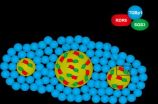(Press-News.org) LOS ANGELES – (June 2, 2014) – The rates of community-onset methicillin-resistant Staphylococcus aureus (CO-MRSA) varied dramatically among academic medical centers in California, New York, Illinois and North Carolina, suggesting there is not a uniform change in the "national epidemic" of the "superbug" that has generated extensive public health concern over the past decade, according to a new study.
The study, published online ahead of print in the journal Clinical Infectious Diseases, surveyed hospital records of 4,171 cases of MRSA and MRSA-related infections between 2008 and 2011 in five medical centers located in Los Angeles, San Francisco, Chicago, New York City and Raleigh-Durham, NC.
The rates of MRSA acquired in the community declined 57% from 2008-2011 in the Los Angeles medical center. In contrast, CO-MRSA rates tripled at the New York medical center, while the rates remained stable in San Francisco, Chicago and Raleigh-Durham. At the same time, the rates for a MRSA-related infection, methicillin-susceptible S. aureus (MSSA), tended to change in the opposite direction from MRSA rates.
Since MRSA and MSSA rates moved in opposite directions, the authors concluded: "Enhanced infection control efforts are unlikely to account for such variation in community onset infection rates"
"These dramatic differences in the incidence and rate of change in the number of MRSA and MSSA infections indicate ongoing, fundamental changes in bacterial ecology, which need further study to protect public health," said Brad Spellberg, MD, a Los Angeles Biomedical Research Institute (LA BioMed) infectious disease specialist and senior author of the study. "Fully understanding MRSA, MSSA and other antibiotic-resistant infections is essential to finding new approaches to save the lives and protect the health of our patients here and around the world."
First recognized in the early 1960s, MRSA became a major public health concern in the late 1980s because it had become endemic in most U.S. hospitals. In the 1990s, a new wave of the antibiotic-resistant staph infections acquired in the community swept the nation. These were not caused by bacteria that had escaped from the hospital. They were MSSA strains with a novel resistance element. These MSSA strain types, especially the ones with a genetic background known as USA 300, were highly virulent. Driven by the emergence of USA300, the incidence of MRSA infections rose dramatically in the 2000s.
In the mid-1990s, Los Angeles and Chicago were among the first regions in the country to be affected by the emergence of MRSA acquired in the community. The "epidemic" of these community-acquired antibiotic-resistant infections only recently reached New York, leading researchers to conclude that the relatively stable incidence of CO-MRSA in Chicago and the decline in Los Angeles will begin to be seen in East Coast cities in the near future.
"This study also found that more than half the MRSA cases involved the most virulent form of the bacteria, bacterium with the USA300 genetic background. But the incidence varied from 35% at one hospital to 80% at another," said Dr. Spellberg. "All these differences in rates suggest that the epidemiology and other factors of antibiotic resistance vary greatly, requiring further study to fully understand antibiotic-resistant bacteria."
INFORMATION:
Dr. Spellberg is the author of the book, "Rising Plague," which examined the rise of antibiotic resistant infections and the failure to develop new antibiotics to combat them. The other researchers engaged in the study were: Arnold S. Bayer, Loren G. Miller and Raul Macias-Gil, LA BioMed; Michael Z. David, Robert S. Daum, Alison Baesa, Susan Boyle-Vavra and Julia Sieth, University of Chicago; Henry F. Chambers and Joann Volinski, University of California, San Francisco; Vance G. Fowler, Jr. and Thomas H. Rude, Duke University Medical Center, and Belinda Ostrowsky and Philip Gialanella, Montefiore Medical Center/Albert Einstein College of Medicine in New York.
About LA BioMed
Founded in 1952, LA BioMed is one of the country's leading nonprofit independent biomedical research institutes. It has approximately 100 principal researchers conducting studies into cancer, inherited diseases, infectious diseases, illnesses caused by environmental factors and much more. It also educates young scientists and provides community services, including prenatal counseling and childhood nutrition programs. LA BioMed is academically affiliated with the David Geffen School of Medicine at UCLA and located on the campus of Harbor-UCLA Medical Center. For more information, please visit http://www.LABioMed.org
MRSA rates varied dramatically across geographic areas
Researchers studied LA, San Francisco, Chicago, New York and Raleigh-Durham
2014-06-02
ELSE PRESS RELEASES FROM THIS DATE:
Enzyme used in antidepressants could help researchers develop prostate cancer treatments
2014-06-02
LOS ANGELES (May 30, 2014) – An international team of scientists including researchers at the Cedars-Sinai Samuel Oschin Comprehensive Cancer Institute and the University of Southern California found that an enzyme commonly used as a target for antidepressants may also promote prostate cancer growth.
The study, published in the Journal of Clinical Investigation, found that suppressing the enzyme monoamine oxidase A, or MAOA, may reduce or even eliminate prostate tumor growth and metastasis in laboratory mice. The finding could open the door for physicians to use antidepressants ...
Virus rounds up enzymes, disarms plant
2014-06-02
University of Tokyo researchers have described how a plant-virus protein suppresses an important plant defense mechanism that remembers viral genetic information, providing a new target for developing the first-ever chemical against plant viruses that globally cause more than $60 billion of crop losses each year.
Invading viruses carry genetic material that hijacks the host cell's machinery, fooling it into producing proteins and new viruses. All cells from fungi to plants and mammals employ RNA silencing, a cellular process essential for the regulation of gene expression ...
New Population Council research presented at 13th ESC Annual Congress
2014-06-02
LISBON, PORTUGAL (31 May 2014) – This week, the Population Council presented new research at the 13th Congress of the European Society of Contraception and Reproductive Health. Presentations included a pharmacokinetic analysis of the Council's investigational one-year contraceptive vaginal ring containing Nestorone® and ethinyl estradiol, and its investigational male contraceptive implant MENT®, as well as new approaches to "green contraception," including strategies to ensure that future contraceptive technologies are both effective and protect the environment.
"The ...
Clinical trial shows drug combination may be effective in recurrent ovarian cancer
2014-06-02
VIDEO:
Dr. Joyce Liu talks about her clinical trial showing drug combination may be effective in recurrent ovarian cancer.
Click here for more information.
CHICAGO –– Significant improvement with the use of a combination drug therapy for recurrent ovarian cancer was reported at the annual meeting of the American Society of Clinical Oncology (ASCO) meeting in Chicago today. This is the first ovarian cancer study to use a combination of drugs that could be taken orally. The ...
New data shows ProMark accurately predicts aggressive prostate cancer, pathology outcomes
2014-06-02
CAMBRIDGE, Massachusetts, June 2, 2014 – Today, for the first time, Metamark presents results from the clinical validation study that showed ProMark™, the first and only proteomic-based imaging biopsy test, achieved its primary endpoint by accurately differentiating between aggressive and non-aggressive forms of prostate cancer at early stages of disease. ProMark™ was shown to predict which patients have low-risk disease with a sensitivity of 90 percent or better, confidently identifying patients who are appropriate for active surveillance or need aggressive therapy. The ...
Study shows tale of 2 prognoses in pediatric brain tumor, pilocytic astrocytoma
2014-06-02
Pilocytic astrocytoma (PA) is a primarily pediatric brain tumor caused mainly by mutations in the BRAF gene. In fact, there are two specific mechanisms for activation of BRAF implicated in PA formation: by fusion of the gene with nearby gene KIAA1549 (K:B fusion) or by point mutations of the BRAF gene itself. Research presented at the American Society for Clinical Oncology (ASCO) Annual Meeting 2014 used a newly designed test for K:B fusion to show that point mutations lead to a more dangerous form of the disease than does K:B fusion.
"Overall, the prognosis for Pilocytic ...
DREAM project crowdsources answer to cancer cell drug sensitivities
2014-06-02
A study published June 1 in the journal Nature Biotechnology describes the results of an open challenge to predict which breast cancer cell lines will respond to which drugs, based only on the sum of cells' genomic data. The winning entry, from the Helsinki Institute for Information Technology, was 78 percent accurate in identifying sensitive versus resistant cell lines, and was one of 44 algorithms submitted by groups from around the world.
"The idea is simple – we have this question and anybody can participate in searching for the answer. The question is, do we have ...
A master of disguise: A new stick insect species from China
2014-06-02
Many representatives of the fauna possess unique masking abilities but stick insects are among the masters of disguise within the animal world. During a field trip in Guangxi, China Mr. Ho Wai-chun George from the Hong Kong Entomological Society discovers a new species from this enigmatic insect group, which he describes in a recent research paper published in the open access journal Deutsche Entomologische Zeitschrift.
Like the name suggests the new stick insect Sinophasma damingshanensis is distinguished by peculiarly elongated body and green-brownish coloration, which ...
New species from the past
2014-06-02
A piece of Eocene Baltic Amber of about 45 million years age contains a well preserved extinct flat bug, which turned out to be a new species to science. This exciting discovery is one of the many secrets that deposits of Baltic amber have revealed in the last years and are yet to come in the future. The study describing the new species was published in the open access journal Deutsche Entomologische Zeitschrift.
The new species Aradus macrosomus is a rather large representative of the genus, differing by its size and particular structures from its congeners. The name ...
Same face, many first impressions
2014-06-02
Slight variations in how an individual face is viewed can lead people to develop significantly different first impressions of that individual, according to research published in Psychological Science, a journal of the Association for Psychological Science.
"Our findings suggest that impressions from still photos of individuals could be deeply misleading," says psychological scientist and study author Alexander Todorov of Princeton University.
Previous research has shown that people form first impressions about someone's personality after viewing their face only briefly. ...
LAST 30 PRESS RELEASES:
University of Oklahoma researcher awarded funding to pursue AI-powered material design
Exploring how the visual system recovers following injury
Support for parents with infants at pediatric check-ups leads to better reading and math skills in elementary school
Kids’ behavioral health is a growing share of family health costs
Day & night: Cancer disrupts the brain’s natural rhythm
COVID-19 vaccination significantly reduces risk to pregnant women and baby
The role of vaccination in maternal and perinatal outcomes associated with COVID-19 in pregnancy
Mayo Clinic smartwatch system helps parents shorten and defuse children's severe tantrums early
Behavioral health spending spikes to 40% of all children’s health expenditures, nearly doubling in a decade
Digital cognitive behavioral treatment for generalized anxiety disorder
Expenditures for pediatric behavioral health care over time and estimated family financial burden
Air conditioning in nursing homes and mortality during extreme heat
The Alps to lose a record number of glaciers in the next decade
What makes a good proton conductor?
New science reporting guide published for journalists in Bulgaria
New international study reveals major survival gaps among children with cancer
New science reporting guide published for journalists in Turkey
Scientists develop a smarter mRNA therapy that knows which cells to target
Neuroanatomy-informed brain–machine hybrid intelligence for robust acoustic target detection
Eight SwRI hydrogen projects funded by ENERGYWERX
The Lundquist Institute and its start-up company Vitalex Biosciences Announces Strategic Advancement of Second-Generation fungal Vaccine VXV-01 through Phase 1 Trials under $40 Million Competitive Con
Fine particles in pollution are associated with early signs of autoimmune disease
Review article | Towards a Global Ground-Based Earth Observatory (GGBEO): Leveraging existing systems and networks
Penn and UMich create world’s smallest programmable, autonomous robots
Cleveland researchers launch first major study to address ‘hidden performance killer’ in athletes
To connect across politics, try saying what you oppose
Modulating key interaction prevents virus from entering cells
Project explores barriers to NHS career progression facing international medical graduates
Jeonbuk National University researchers explore the impact of different seasonings on the flavor perception of Doenjang soup
Two Keck Medicine of USC Hospitals named Leapfrog Top Teaching Hospitals
[Press-News.org] MRSA rates varied dramatically across geographic areasResearchers studied LA, San Francisco, Chicago, New York and Raleigh-Durham





